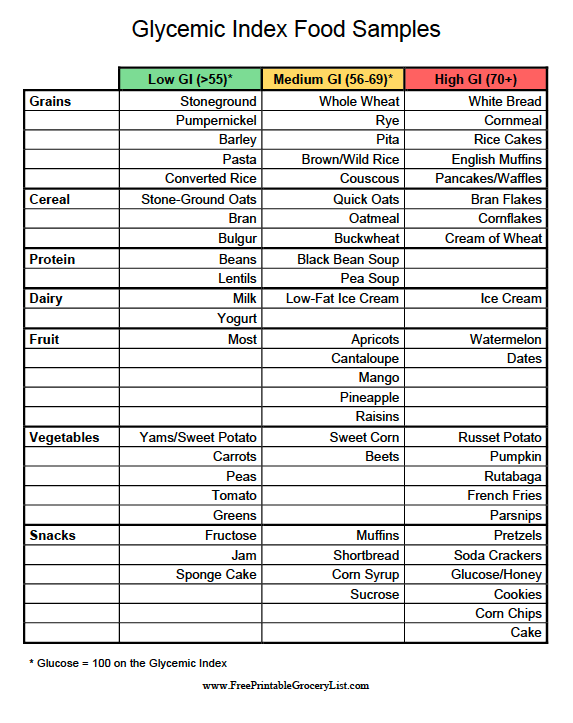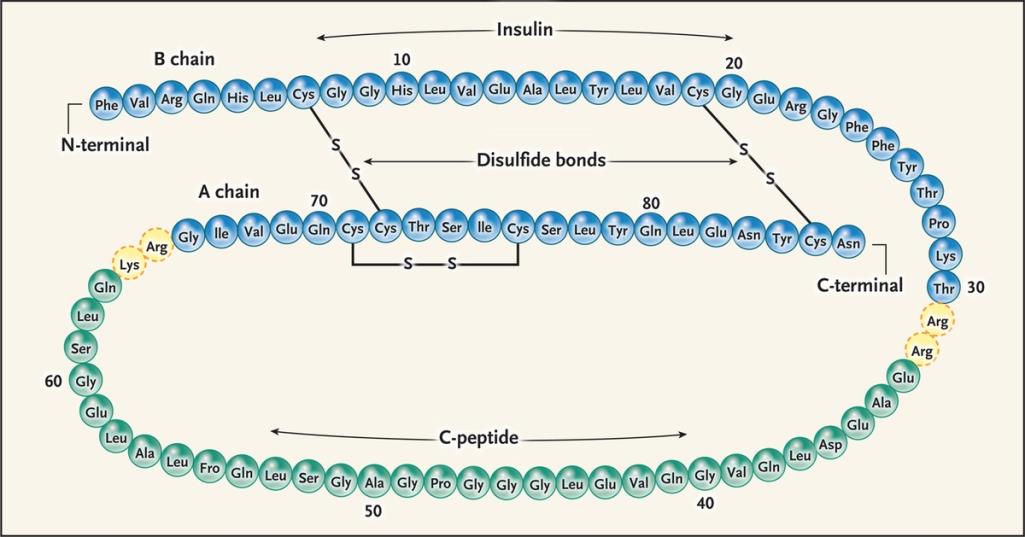
Medical Bits – Vol. 2.9: Your Health and Medical News
Your Metabolism
As you know, multicellular organisms (just like communities and Nations) require communication and coordination between countless cells and constituents to ascertain the healthy completion of bodily functions. Our cells are interconnected in very complex ways through chemical and neural mediators.
Hormones are signaling chemicals that are secreted by glands conforming the endocrine system and regulate many bodily functions such as growth, development, reproduction, digestion, metabolism, sleep, excretion, lactation, stress responses and even mood (you may be trying to explain your mood and stress responses after the recent National elections and their aftermath…). We have decided to review one of the most common endocrine malfunctions: Diabetes and in particular type II diabetes, which affects almost one third of humans walking into medical clinics.
The first reference to Diabetes was found in the Ebers Papyrus, one of the oldest and most important medical papyri of Ancient Egypt and written around 1550 BC (but likely a copy of much earlier texts dating back to the times of the First Dynasty of 3400 BC). Ayurvedic scholars from India first noted the sweet taste of Diabetic Urine and called the condition madhumeha (“honey urine”) by 500-600 BC. Demetrius of Apamea coined the term “Diabetes” in the first century BC and Johann Peter Frank recognized diabetes mellitus (honey) from diabetes insipidus (without taste) in 1794, as Napoleon began his improbable military and political career which would forever change the course of European history.
Joseph von Mering and Oskar Minkowski discovered the central role of the pancreas in 1889 and Edouard Laguesse suggested that “islet cells” of the pancreas may regulate digestion and at the beginning of the 20th century, physicians hypothesized that those islet cells were responsible for the secretion of a protein they named “insulin” that help metabolize carbohydrates. Without insulin, there was no effective treatment and type I Diabetes Mellitus was predictably fatal within weeks to months.
Although it is still associated with a reduced life expectancy, the prognosis has vastly improved over the past century.
The discovery and purification of insulin was achieved by a group of researchers at the University of Toronto in the early 1920’s.
Drs. Frederick Banting, JJR Macleod, Charles Best, James Collip discovered insulin when they reversed induced diabetes in dogs by injecting an extract from the pancreatic islet cells of healthy dogs. They purified the hormone insulin from bovine pancreases and were the first to use it to treat a patient with Diabetes. They were awarded the Nobel Prize in Physiology or Medicine in 1923. Several Nobel Prizes were awarded in the 20th Century for diabetes-related investigations leading to revolutionary and effective treatments.
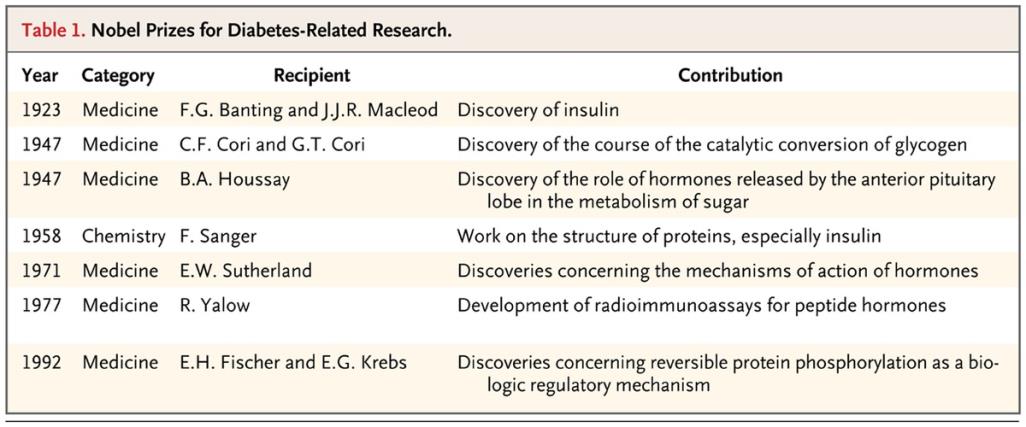
From NEJM, 367;14 2012
Diabetes Mellitus
As you know, the condition is characterized by elevated glucose levels. Type I refers to the autoimmune destruction of pancreatic beta cells responsible for their manufacture and it is more frequent in children and adolescents, but may also happen in adults, accounting for 5-10% of the total number of diabetes in adults. The absolute deficiency of insulin leads to specific manifestations that are uncommon in Type II Diabetes.
In type II Diabetes, there is insulin resistance, but also relative impairment in insulin secretion and a very strong association with obesity (in particular central or visceral (belly fat) obesity). The prevalence has been rising in the last five decades in direct relationship to rising weight of humans throughout the world. It is more common in Native Americans, African Americans, Hispanics and Asian Americans than in the general population. Many patients present without symptoms (40%) but the rest have manifestations such as excessive thirst and frequent urination. Rarely, more serious problems such as ketoacidosis (excessive acidity) or hyperosmolarity (very high glucose levels) may lead to acute emergencies.
As the sugar levels rise in the blood, the hemoglobin binds some of those glucose molecules. First described in 1958, by the 1970’s it was proposed as a diabetic monitoring tool. Thus, a HgbA1c level above 6.5% on two separate occasions is sufficient to diagnose diabetes and a level between 5.7 and 6.4% indicates increased risk for diabetes, termed pre-diabetes. A fasting plasma glucose > 126 mg/dl is also diagnostic and levels from 100-125 mg/dl indicate prediabetes.
If type I DM is suspected, testing for pancreatic auto-antibodies becomes relevant, which is not always clear in obese adolescents and young adults. Some patients may have mixed overlapping features of type I and type II Diabetes. We should also remember that other conditions may cause diabetes, such as cystic fibrosis, hemochromatosis, recurrent pancreatitis, corticosteroids, cyclosporine, tacrolimus and others.
Diabetes Mellitus type II
It is somewhat ironic that as our understanding of biology and effective treatments have been developed, not only a cure remains elusive, but we may arguably be worse off than 50 years ago.
This is due to the increasing weight of Humanity, leading to insulin resistance, type II DM and another ongoing “pandemic” which has been worsening for the past 50-60 years!
You would not be surprised to learn that the rise in Diabetes type II prevalence correlates directly with the rise in sugar consumption and consequent increase in rates of obesity. Reviewing the fascinating and infamous history of sugar would probably take weeks.
Briefly, after the domestication of the sugarcane plant in Southeast Asia some 6000 years ago, most of the cultivation and trade originated in India, the Islamic world and finally the Portuguese promoted their exploitation in the Madeira Isles. Upon discovery of the “New World” the tropical conditions suitable for their cultivation and the intensive nature of the crop requiring grueling labor promoted the slave trade and another dark chapter of history.
Sugar is the most popular ingredient added to foods in the US and it is added to most processed foods (think ketchup, crackers, bread, soups, cereals, peanut butter, cured meats, salad dressings, etc.). One teaspoon of white sugar has 15 calories, but one teaspoon of corn syrup has 20 calories. Soft drinks are responsible for most of the added sugar in the average American diet. One can of soda contains about 11 teaspoons of sugar. Two hundred years ago, the average American ate only 2 pounds of sugar annually. In 1970,123 pounds and today, the average American consumes almost 152 pounds of sugar in one year !!! We now consume in one week our annual “allotment”! We should get only 10% of calories from sugar and no more than 10 teaspoons per day. The current average is 42.5 teaspoons of sugar per day!
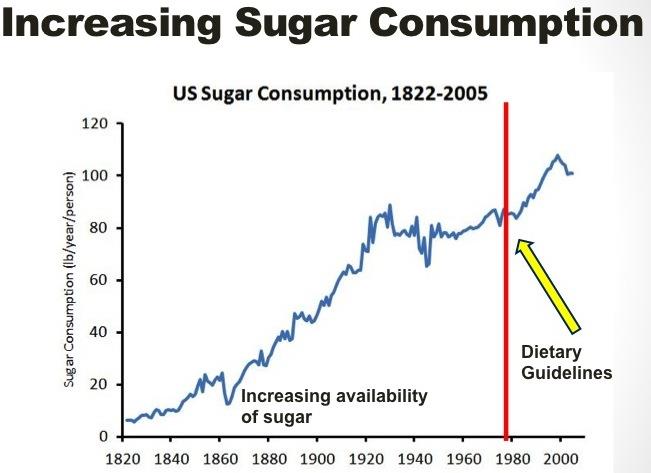
Of course, limiting sugary drinks and decreasing the availability of high caloric food-sources in schools by the Obama Administration was “an overreach of power by the Federal Government and an attempt to curve civil liberties”… Just like the support of End of Life discussions by the ACA were labeled “death squads” by those opposed. You realize how difficult it is to make rational decisions that may help our society and our common goals when disinformation permeates our daily discourse. But we can all agree that if somehow you find yourself in a supermarket, steer clear of any “food” that your mother or grandmother could not have possibly recognized! Limit processed and artificial junk and anything that has excessive carbohydrates!
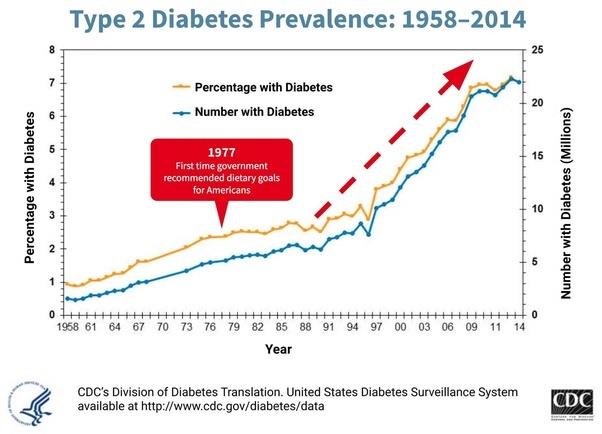
In both, type I and type II diabetes, multiple genes and environment are implicated. Genetic studies have identified over 40 genetic variants that increase the risk of type II diabetes, but they account for only 10% of cases and increase the individual risk of diabetes by 10-15%. Since so many genes contribute to the overall risk, it is difficult to quantify each or develop prevention and treatment based on these genetic profiles.
At this point, you may argue that most humans are rational creatures who would not want to take unnecessary risks leading to disease. One of the problems may be that sugar can be a substance of abuse and lead to a natural form of addiction. “Food addiction” seems plausible as brain pathways that evolved to respond to natural rewards are also activated by sugar intake, leading to release of opioids and dopamine in the brain pleasure centers and thus, it might be expected to have addictive potential. If interested in this subject, I invite you to read this review: https://www.ncbi.nlm.nih.gov/pmc/articles/PMC5946262/
We know that lifestyle interventions, such as weight loss of 5-7% of body weight and adding 150 minutes of exercise reduce the risk of Diabetes by almost 60% overall (and by over 70% for people over 60-year old).
https://www.cdc.gov/diabetes/prevention/people-at-risk.html
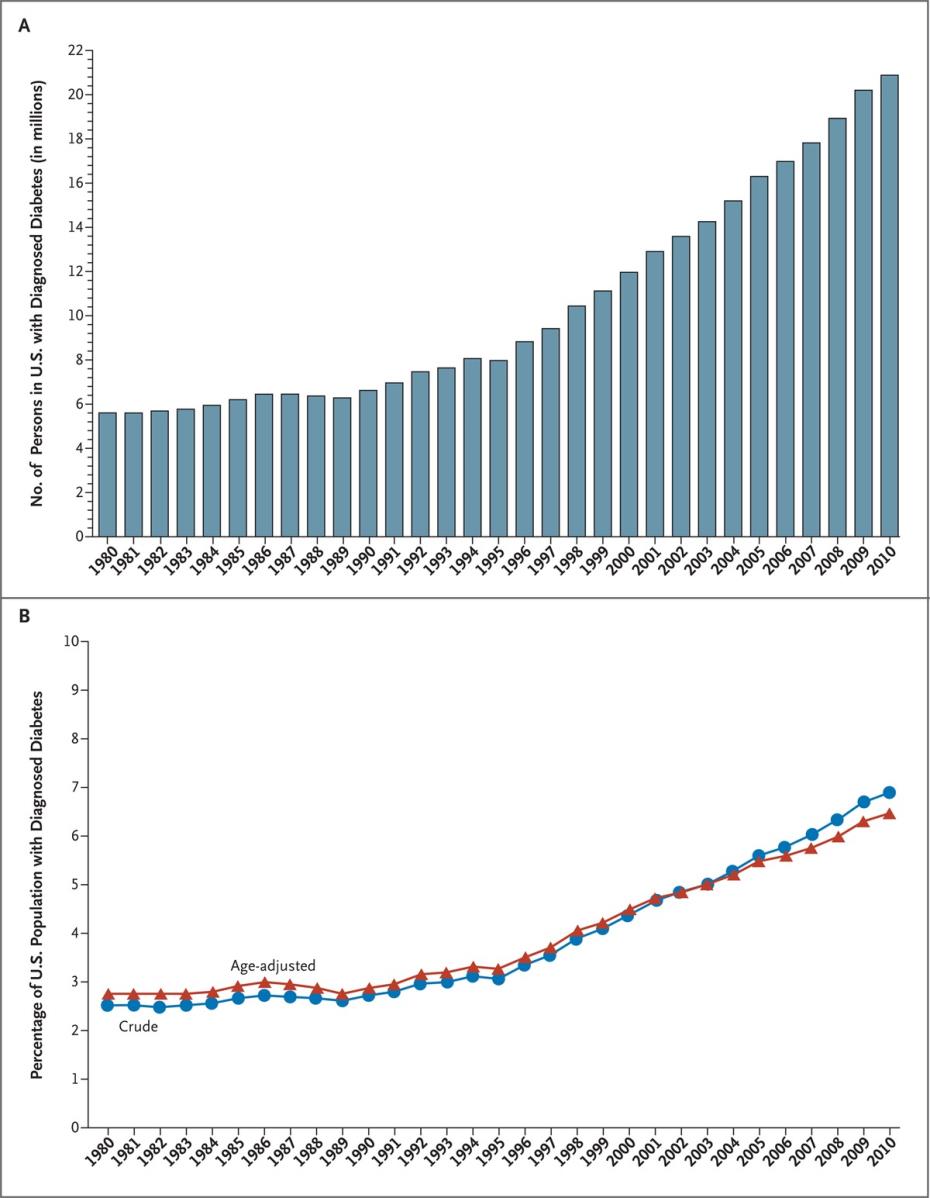
As you can see, as the weight of Humanity has increased, so has the prevalence of diabetes. Now over 30% of adults over 65 have diabetes and if the current trends continue, by 2050 1 in 3 of the American population will suffer the condition.
The human, direct and indirect costs related to diabetes threaten to overwhelm not only health-care systems but national budgets!
The World Health Organization’s (WHO) 2015 sugar guidelines recommends that adults and children consume less than 10% of daily calories from free sugars (sucrose), with a further reduction to 5% being ideal with additional benefits to reduce the burdens of diabetes, obesity and dental decay.
- Globally, the number of humans living with diabetes have increased from 108 million in 1980 to almost 500 million by 2020.
- Global prevalence among adults was 4.7% and now almost 10%.
- Since 2000, there has been a 5% increase in premature mortality due to diabetes and its prevalence has risen more rapidly in low and middle-income nations.
- In 2019, diabetes caused an estimated 2 million deaths.
- Diabetes is a major cause of blindness, renal failure and vascular disease, including heart attacks, strokes and lower limb amputations.
My educated patients would not be surprised to learn that the food and beverage industry has laboriously opposed government efforts throughout the world to regulate and limit the amount of free-sugar consumption for many decades. For a full review of the decades-old successful battle to limit sugar regulation, you may read this: https://bmcpublichealth.biomedcentral.com/articles/10.1186/s12889-019-7401-1
Of course, you know this is not an exceptional skirmish in our “mature” societies. The Tobacco Industry and their lobbying groups fought and continue to undermine efforts to regulate tobacco products despite the millions of humans who die and suffer daily as a result of their manufacture.
The Gun Industry and their lobbying groups continue to assault their regulatory demise with historical and grandiloquent references to that mystical document called Constitution (as if those ambitious pages were not the consequence of arduous debates and opposite view-points that should be interpreted under a historical perspective, taking into account the realities of the late 18th century and arguably need to be updated to fulfill the needs of a modern society with its urban life and millions of citizens living in close proximity, where “civility” is paramount).
The Petroleum Industry fights efforts to shift towards cleaner sources of energy and has pocketed even more politicians to their camp, successfully eliminating “Global Warming” from the public debate that for many years shifted to Climate change and brought into question thousands of independent observations. In this regard, the Trump “Administration” has been very successful! With a few tactful slogans, (oftentimes supplied by Industry lobbying groups) hundreds of well-intentioned regulations have been eliminated.
This debate of opposites reminds us of Plato and his Phaedo when Socrates mounts a defense of the immortality of the soul right before decidedly drinking the famous hemlock and sealing his eternity:
– “Are not all things which have opposites generated out of their opposites? I mean such things as good and evil, just and unjust -and there are innumerable other opposites which are generated out of opposites. I mean to say, for example, that anything which becomes greater must become greater after being less.
– True. (Cebes)
– And that which becomes less must have been once greater and then have become less.
– Yes.
– And the weaker is generated from the stronger, and the swifter from the slower.
– Very true.
– And the worse is from the better, and the more just is from the more unjust.
– Of course.
– And is this true of all opposites? Are we convinced that all of them are generated out of opposites?
– Yes.
– And there are many other processes, such as division and composition, cooling and heating, which equally involve a passage into and out of one another. And this necessarily holds of all opposites.
– Very true
– Well, and is there not an opposite of life, as sleep is the opposite of waking?
– True (said Cebes).
– And what is it?
– Death, he answered.
Of course, at this point in his dialogue, we may decide to agree with Socrates that the dead originate from the living and the living from the dead… or Not. After 2500 years that eternal debate continues for many.
There are numerous public health efforts to limit disease and prevent human suffering!
The benefits of picking up the pace of your exercise and activities is beyond dispute. Likewise, limiting sugar, trans-fat and high-fat diets improve our health results and longevity!
And remember, just one simple 250cc sugary drink (one Coke) daily increases the risk of type II Diabetes Mellitus by over 25%!!!
DIABETES TREATMENT
The natural history in diabetes, is for glucose levels to gradually rise over time and continuous treatment is necessary. The target is to achieve a glycosylated hemoglobin (Hgb A1c) < 7% but there are exceptions in older individuals or those with a poor overall prognosis. Micro-vascular (retina – glomeruli of the kidneys, etc.) and macro-vascular (coronaries – carotids – cerebrovascular) complications can be prevented by keeping the Hgb A1c < 7%.
In type II diabetes, monitoring these levels is as effective as glucose monitoring and hence, there is no good reason to lance your fingertips and measure sugar levels frequently. To achieve those levels, the glucose goals are a fasting glucose 80-130 mg /dl and after meals <180 mg/dl.
Monitoring Hgb A1C levels twice yearly if levels are adequate and below 7% and every 3-4 months if not on target is sufficient. To achieve such control:
- Lifestyle changes: Diet, increased activity, weight loss.
- Metformin is first-line treatment and indicated for most patients. It has been shown to reduce progression to diabetes as well and it is also indicated in Pre-diabetes.
- 50% controlled on one drug.
- After 3 years of diagnosis ½ require a second drug and by 9 years after diagnosis 75% require a third drug to remain on target.
- Another important class of drugs, glucagon-like peptide 1 receptor agonists (GLP-1) such as semaglutide, dulaglutide or liraglutide help with weight loss (on average 12 lbs) and have excellent safety profiles, reducing cardiovascular complications and also decrease Non-Alcoholic Steato-hepatitis, commonly associated with obesity.
- In patients with heart failure or chronic kidney disease, another class of drugs named Sodium Glucose Co-Transporter II inhibitors (empagliflozin, canagliflozin, dapagliflozin) is very effective and associated with better outcomes in those with heart failure and provides renal protection, but their efficacy declines if the kidney’s filtering capacity is below 30 ml/min.
- Sulfonylureas such as glimepiride and glipizide are cheap and effective but do not help with the goal to reduce weight.
- Long-acting insulins can be introduced if glucose control is not adequate despite oral treatments.
- A large study analyzing almost 300 trials, demonstrated that combinations of metformin with semaglutide and/or dapagliflozin or agents within these classes were associated with the best reduction in Hgb A1c and lower cardiovascular complications.
Remember;
- Nutritional choices are important: keep the glycemic index of different meals in mind as this will help you make better choices:
It is important to control Cholesterol levels
- Do Not Smoke
- Treat Hypertension!
- Exercise! This is part of being humans! Nothing special about it!
- If you have any vascular disease, a daily baby aspirin may be beneficial.
- Regular eye exams by an ophthalmologist every 1-2 years.
- Examine your feet and wear comfortable shoes, particularly if nerve damage from diabetes present.
- Most diabetic patients benefit from BP pills such as losartan (and its class) or lisinopril (and its class).
MEDICAL NEWS:
SARS-CoV2 Vaccine Development
This past week, the Pfizer – BioNTech joint mRNA vaccine reported preliminary efficacy of over 90%, buoying humanity (and markets) into cheers. It would require two sequential injections and possibly be ready by mid-December / early January 2021. Their novel vaccine appeared to be more than 90% effective, surpassing the 70% goal. Today, Moderna – NIAID report that their mRNA vaccine was 94% effective! Within a few weeks the firms could have the data necessary to obtain Emergency Authorization from the regulatory agencies and put it to work! Let’s remember that not only the vaccine was developed in 10 months, but also new technology was engineered to manufacture antigen and deliver this important achievement!
Vaccines against viruses most commonly used “attenuated” or debilitated strains of the virus so as to coax the body to build defenses but not cause disease. The novel vaccine development has used genetic engineering, targeting the gene for the distinctive spike protein that studs the virus’ membrane hoping it would provoke a brisk immunogenic response. Other joint ventures used the spike gene, inserting it into the genome of a harmless adenovirus which after infecting human cells it too, makes them produce spike proteins that trigger an immune reaction. And it appears to be working!
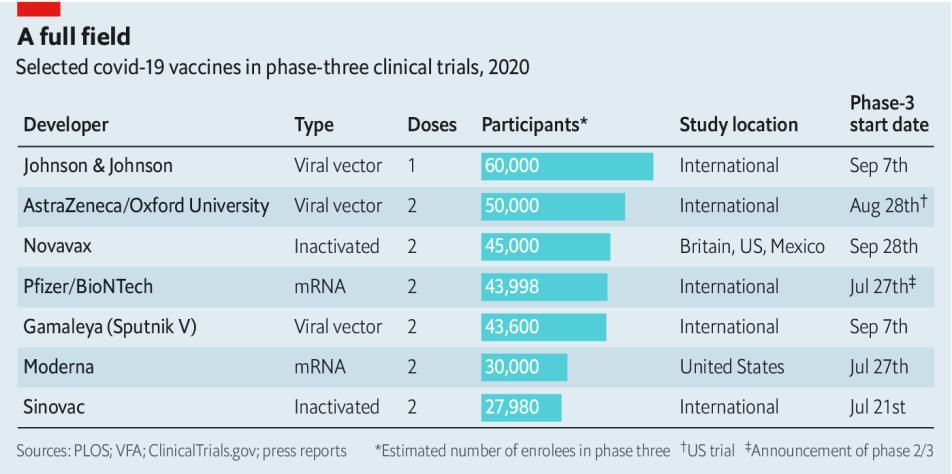
Once these novel vaccines are approved for widespread use, the world will face a serious supply-chain challenge. To read more: https://www.economist.com/briefing/2020/11/14/an-effective-covid-19-vaccine-is-a-turning-point-in-the-pandemic
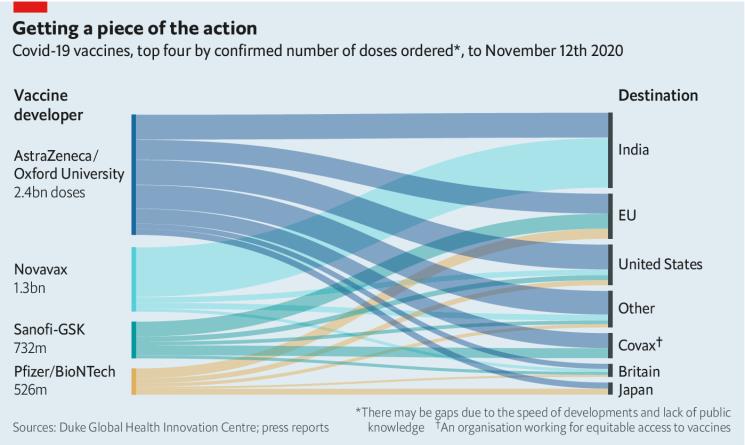
Also, the interactive feature from the NYT is updated frequently: https://www.nytimes.com/interactive/2020/science/coronavirus-vaccine-tracker.html
As summarized by the Coronavirus Vaccine Tracker, there are now more than 12 vaccines in large phase III efficacy trials, 16 in phase II expanded safety trials and 36 in phase I trials, testing safety and proper dosage. Another excellent vaccine development update from Nature: https://www.nature.com/articles/d41586-020-01221-y
Vaccine allocation
When is it my turn to get this long-awaited vaccine?
As we discussed in our last Newsletter, a vaccine will be deployed before the end of 2020 / Q1 2021 and it will be distributed in stages. In mid-September, the World Health Organization and the US National Academy of Sciences, Engineering and Medicine have proposed a five-phase plan to fairly allocate a coronavirus vaccine internationally and to US residents respectively. I invite you to read more about it here: https://www.who.int/publications/m/item/fair-allocation-mechanism-for-covid-19-vaccines-through-the-covax-facility and here: https://www.nap.edu/catalog/25914/discussion-draft-of-the-preliminary-framework-for-equitable-allocation-of-covid-19-vaccine
Debunking Myths: Q&A
1. Once I am diagnosed with Diabetes, am I “doomed”
In fact, use of metformin, aggressive weight loss, limiting carbohydrates and routine exercise have been shown to reverse the condition (remember that muscles do not need insulin to burn carbohydrates and therefore, daily and routine exercise are paramount!). Consider downloading exercise applications and tailor the activities to your tolerance. We can all do more! No exceptions!
2. Are all Coronavirus tests the same?
No. One is the virus test, to learn if you are actively infected and the other is the antibody test to learn if you have been infected in the past and have immunity. The most accurate virus test is the Polymerase Chain Reaction – PCR which identifies the gene of the virus in nasopharyngeal secretions or saliva. It is more accurate but more expensive and labor intensive. Rapid tests identify specific viral antigen or coronavirus proteins implying active infection. They are less accurate but faster and cheaper. Some of our patients ask if we offer the antigen tests: NO. Due to concern for increasing traffic and bringing in individuals who could possibly carry the virus and expose our patients, we decided not to offer testing.
3. Where can I be tested?
Locally, there are several sites (Kelly Goodman, NP offers testing through Capital Dx – 202-684-7167; AllCare Family Medicine 301-825-8880 in Glen Echo; ARCpoint labs in Spring Valley 202-880- 3389 and MedStar Urgent Care in Chevy Chase 301-215-9440. You must call for an appointment in advance. There are now mail-options: CareCube https://carecube.clinic/covid-19-testing/ and Pixel by LabCorp, will mail a test and you send back a sample; they promise to send your results within 12 to 34 hours and 36 hours respectively.
4. Asymptomatic individuals do not transmit COVID-19. Myth!
Multiple studies indicate that nearly half of transmissions are from people not feeling ill! https://www.medrxiv.org/content/10.1101/2020.09.04.20188516v2
5. Do antibodies last and could I get re-infected with COVID-19? Myth!
The fact that after more than 6 million cases worldwide only one case was confirmed to have developed reinfection suggests to me that this is a very rare phenomenon. In late August, a 33-year-old Hong Kong resident, who had his initial infection in the early Spring, tested positive again upon return from Spain via the UK. He remained asymptomatic and mounted a vigorous antibody response to the second strain, confirmed by genetic analysis. Antibodies last several months and our cellular immunity takes over after antibody titers wane. https://www.nejm.org/doi/full/10.1056/NEJMoa2026116?query=featured_coronavirus
Antibody titers appear to remain elevated for 4-5 months after infection and then they start to decline. Gleaning information from the SARS-CoV1 epidemic of 2002, adequate titers of neutralizing antibodies remained elevated 2-3 years after acute infection.
6. COVID-19 is associated with increased risk of clotting and therefore we should take aspirin or blood thinners. Myth!
Patients who develop severe COVID-19 disease and usually those requiring ICU support, may go on to develop microthrombi and disseminated intravascular coagulation. For those patients, anticoagulation treatment is standard and decided by the ICU team at the time of care. Use of preventive blood thinners is unfounded!
7. Is the virus mutating to be able to be infectious through the skin?
No! there is no evidence that this is possible. The virus utilizes special receptors located in the respiratory epithelium called ACE-2 (Angiotensin Converting Enzyme type II) to be internalized and infect epithelial cells. Furthermore, the probability of becoming infected from packages and surfaces is extremely low. Stop wasting time and disinfecting surfaces and packages. Not likely to get to your upper airway in an adequate infectious dose.
8. Is the virus mutating such that development of an effective vaccine is in peril?
Of course, the virus is mutating, just like any other virus multiplying in the trillions and infecting millions of hosts, but there is no evidence that the minor mutations will lead to major changes in the antigens and virulence of the virus. SARS-CoV2 is a stable, non-segmented RNA virus and major mutations to alter immunogenicity and virulence during the course of the pandemic would be surprising.
9. UV light / silver and copper-based agents destroy SARS-CoV2 and are effective preventive or treatment modes. Myth!
While prolonged UV light may inactivate the virus, using UV light has no immediate effects and is potentially harmful. Metal-based products have no known effect on the virus
10. Do masks help decrease the severity of illness and could they diminish Influenza transmission?
Likely YES! There appears to be a relationship between the infectious dose and severity of illness. The rate of asymptomatic infection was estimated at 40% by the CDC in mid-July, but they have been reported to be > 80% with universal masking. In a closed Argentinian cruise ship outbreak, where all passengers and staff were provided with masks, the rate of asymptomatic infection was 81% (compared to 20% in earlier ship outbreaks). https://www.nejm.org/doi/full/10.1056/NEJMp2026913
Prevention!
Finally, allow me to repeat one more time that we should continue to support the World Health Organization (WHO) and promote reform as an active member!
For a brief and insightful comment, read this: https://www.nejm.org/doi/full/10.1056/NEJMe2024894?query=featured_home
Of course, humanity continues to witness so many preventable deaths and so much avoidable suffering. Yet, we have the tools to do better!



Ozzy Covy Picone Celebrating Election Results!
In the meantime, what can we do to prevent infection and disease?
Keep cool, do not panic, eat a nutritious and diverse diet, stay active and be happy!
Use a properly fitted mask while in public indoor places.
Take a multivitamin daily and don’t forget your 1000-2000 IU of vitamin D3.
Be ready to accept vaccination as soon as it becomes available. Likely by early 2021.
And let’s try to make the best lemonade with the “lemons” nature has thrown our way!
Fear is not a rational response. This too shall pass! Do not anguish about rare problems unless you have won the lottery more than once.
Remember that the only certainty in life is… death… (and TAXES, unless you are a famous shameless cheater rewarded with an important Public Servant job near you, but thankfully leaving soon!) and the only fountain of youth proven by science, experience and millennia are exercise, laughter, humor and a good positive attitude!
Enjoy every minute of this most interesting JOURNEY and cherish your family time!!!
Carlos Picone, MD
5215 Loughboro Rd, Suite 400
Washington, DC 20016
301-656-7374
cpicone@chevychasepulmonary.com
References:
- https://www.nejm.org/coronavirus
- https://www.cdc.gov/coronavirus/2019-nCoV/index.html
- https://www.who.int
- https://clinicaltrials.gov/
- https://www.nature.com/articles/d41586-020-00154-w
- https://www.nejm.org/doi/full/10.1056/NEJMe2025111
- https://www.nejm.org/doi/full/10.1056/NEJMe2024894?query=featured_home
- https://science.sciencemag.org/content/early/2020/05/12/science.abc5312
- https://www.nejm.org/doi/full/10.1056/NEJMp2005630?query=featured_coronavirus
- https://www.youtube.com/watch?v=-Gn8oJY1VHY&feature=youtu.be
- https://www.cfr.org/backgrounder/what-world-doing-create-covid-19-vaccine
- https://www.ncbi.nlm.nih.gov/pmc/articles/PMC3805090/
- https://www.nejm.org/doi/full/10.1056/NEJMcibr2009737?query=featured_coronavirus
- https://jamanetwork.com/journals/jama/fullarticle/2767840
- https://www.nature.com/articles/d41586-020-00502-w
- https://www.nap.edu/catalog/25914/discussion-draft-of-the-preliminary-framework-for-equitable-allocation-of-covid-vaccine
- https://www.economist.com/briefing/2020/11/14/an-effective-covid-19-vaccine-is-a-turning-point-in-the-pandemic
ANNEX: COVID-19 Timeline
From Nature:
https://www.nature.com/articles/d41586-020-00154-w
- 21 December, 2019, a few patients became ill with severe pneumonia in Wuhan, Hubei province of China.
- 31 December, 2019, a new virus is identified in samples from 4 patients with pneumonia of unknown cause. All patients had been present at the Huanan Seafood Market in Wuhan. Viral genome isolated and sequenced. Initially named 2019-NCoV (Novel Coronavirus 2019).
- 8 January, 2020 – Nature reports on the new virus, cause of mysterious “deadly pneumonia” in Wuhan, China.
- 21 January, 2020 – First US case confirmed in Washington State. 30 yo man returning from Wuhan, China.
- 23 January, 2020 – China closes Wuhan.
- 24 January, 2020 – Second US case. 60 yo woman returning to Chicago after visiting China.
- 28 January, 2020 – Human-to-human transmission confirmed in Germany.
- 3 February, 2020 – Study of live virus published.
- 6 February, 2020 – Retrospective autopsies completed in mid-April in Santa Clara, CA confirms that first deaths occurred in early Feb.
- 14 February, 2020 – Chinese authorities reveal number of infections in medical staff: 1,716 health workers had contracted the virus, 6 of whom died
- 17 February, 2020 – First case in Africa
- 25 February, 2020 – U.S. emergency funding for coronavirus response
- 26 February, 2020 – Brazil reports first case in South America
- 28 February, 2020 – Coronavirus spreads to sub-Saharan Africa
- 4 March, 2020 – Multiple drugs under investigation for coronavirus
- 5 March, 2020 – China study suggests children are as likely to be infected as adults, but most do not become ill.
- 11 March, 2020 – Transgenic animals for CV research in high demand
- 11 March, 2020 – Coronavirus becomes a pandemic, says WHO.
- 13 March, 2020 – US President declares “national emergency”. It is no longer a “Chinese virus that will blow over by the spring”.
- 17 March, 2020 – First vaccine clinical trials begin in U.S. (National Institute of Allergy and Infectious Diseases (NIAID) and Moderna (biotechnology company in Cambridge, MA) – “launched in record speed,” 66 days from genetic sequencing of virus to the first human injection of the vaccine candidate.
- 18 March, 2020 – Deaths in Italy surpass those in China.
- 19 March, 2020 – No new cases confirmed in Hubei, China.
- 25 March, 2020 – Retrospective studies in Lombardy confirm that the virus was present in Northern Italy in early January 2020.
- 1 April, 2020 – Over 80% of ICU patients with COVID-19 have underlying medical conditions.
- 2 April, 2020 – Worldwide cases surpass 1,000,000
- 7 April, 2020 – No new reported COVID-19 deaths in China
- 8 April, 2020 – Tracking App reveals lack of smell is key symptom.
- 15 April, 2020 – Trump – in his infinite wisdom and trust-worthy scientific knowledge – suspends WHO funding. Leonardo Da Vinci’s birthday celebrated by “scapegoating” the WHO.
- 15 April, 2020 – Worldwide infections surpass 2,000,000.
- 21 April, 2020 – Mars probe HOPE ships from UAE to Japan for launch after July 15th when Mars and Earth are aligned. It should reach the Red Planet by 2021.
- 21 April, 2020 – https://1daysooner.org/volunteer launched. 15,000 people volunteer to be exposed to virus and accelerate vaccine development.
- 27 April, 2020 – The five ways Trump is undermining environmental protection under the cover of the Pandemic: https://www.nature.com/articles/d41586-020-01261-4
- 29 April, 2020 – Remdesivir speeds up recovery!
- 7 May, 2020 – First CRISPR testing kit approved in US. It works by programming the CRISPR machinery to detect snippets of the virus genetic material and expedites results to 1 hour.
- 15 July, 2020 – Only medications with proven efficacy so far: Remdesivir (antiviral) and dexamethasone, when used in patients with pneumonitis seems to expedite recovery, but not early on. In fact, it may worsen outcomes when used at the outset of disease. Non-Invasive oxygen delivery may be associated with better outcomes.
- 16 July, 2020 – mRNA vaccine able to generate adequate immunogenic responses and phase III clinical trial to begin soon.
- 20 July, 2020 – Recombinant Adenovirus vaccine that encodes SARS-CoV2 Spike protein is highly immunogenic on phase I/II clinical trials conducted in the UK and phase III trials to start soon.
- 27 September, 2020 – Over 33,000,000 cases and almost 1,000,000 deaths worldwide. Over 7,000,000 cases in the US and 205,000 deaths. Pandemic tracker: https://coronavirus.jhu.edu/map.html
- 9 November 2020 – Pfizer – Bio-N-Tech vaccine reported preliminary efficacy of over 90% and buoying humanity (and the markets) into cheers. It would require two sequential injections and possibly be ready by mid-December / early January 2021
- 15 November 2020 – The US reaches 11 million cases and almost 250,000 deaths.
About SignatureMD
SignatureMD is one of the nation’s largest firms providing initial conversion and ongoing support services to concierge medicine physicians. SignatureMD currently partners with over 200 affiliated primary care physicians and specialists across 35 states, and its network is rapidly expanding.
